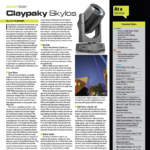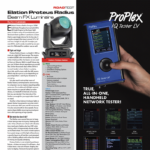The recent video boom has spawned a number of applications that allow you to do pretty much anything with anything. Warping, mapping and multiple layer playback, exotic even a few years ago, are fairly commonplace. But as app designers pack more of these advances into their software bundles, users are yearning for an easy way to arrange and play back some simple files. As a believer in using the right tool for the right job, I was pleased to try out Millumin on a recent gig. I found it to do exactly what I needed.
The Software
Millumin bills itself as a tool to “create and perform audiovisual shows,” and it excels in this respect. It is not, however, a content creation tool. There are plenty of high-powered apps to do that. In fact, Millumin has an After Effects plug-in which allows you to see projection-mapping output live from that app… but I digress. As I stated earlier, it’s the playback that I’m most interested in.
Millumin’s interface is sparse and simple. You get a Library Bin, a Work Surface (that mirrors output) with two areas to manipulate the properties of that surface and a Timeline of sorts at the bottom. The Library Bin is where you drag and store all of your files — videos, images, etc. It’s also where you manage your inputs (should you have any). The Work Surface is where you manipulate your output. It comes complete with a Mapping Tool (Warp-enabled, both Rigid and Bezier), a Mask tool and a Quartz Layer tool. It can do these things with buttons across the top — they’re there if you need them, but not in the way if you don’t.
 The real workhorse of Millumin is down below — the Dashboard and Composition tabs. The Dashboard allows arrangement of media in a column layout familiar to anyone using any type of VJ playback system. There is also a “Continuation” feature of the grid to allow multiple layers to continue playing back. I found this feature to be really handy to create PIP effects that could simply be turned on or off (or faded, if need be). To delete Layers, you’ll need to use a keyboard shortcut or select it from the menu at the top. (I kept wishing for a simple “minus” (-) button next to the active layer.)
The real workhorse of Millumin is down below — the Dashboard and Composition tabs. The Dashboard allows arrangement of media in a column layout familiar to anyone using any type of VJ playback system. There is also a “Continuation” feature of the grid to allow multiple layers to continue playing back. I found this feature to be really handy to create PIP effects that could simply be turned on or off (or faded, if need be). To delete Layers, you’ll need to use a keyboard shortcut or select it from the menu at the top. (I kept wishing for a simple “minus” (-) button next to the active layer.)
The Composition tab allows for media to be arranged in a timeline format. In addition to keyframes, it features “cue points” and the option to “pause on cue points” — incredibly handy. Compositions can be put into the Dashboard, and vice-versa, to further enhance playback. For instance, you can create a composition with cue points, then embed it into the Dashboard and play back from there. As far as layer control, using keyframes, you can control things like opacity, position, and scale if needed.
 Millumin interacts with OSC, MIDI, Art-Net, along with a plug-in called MilluPlug, which furthers Millumin’s extensibility into DMX and Arduino. To sync multiple machines, you can use SimpleSync, another great mini-app that goes along with the main application, and Syphon is supported as well.
Millumin interacts with OSC, MIDI, Art-Net, along with a plug-in called MilluPlug, which furthers Millumin’s extensibility into DMX and Arduino. To sync multiple machines, you can use SimpleSync, another great mini-app that goes along with the main application, and Syphon is supported as well.
Millumin’s output is highly configurable, with four standard presets and “custom” options, along with options for Multi-screen, Soft-edge and Transform. Millumin supports many codecs as well, including PJPEG, my favorite. (On that note — please use fast hard drives, and stay away from H.264. Thank you.)
All the options for Fullscreen, Output, Devices, and Preferences are laid out on buttons cleanly across the top for easy access. There’s even an “Optimize” button that will suggest some things about your project that could be done to improve performance — and it also converts the files to the right codec! And, speaking of performance, Millumin is 64-bit compatible, so those of you running Mountain Lion or Lion will see a big speed jump.
On top of all the easily accessible app buttons, there’s “Ideas” (which jumps you to the main application webpage), “Lab” (which does much the same), and “Support” (for quick access to tutorials, suggestions, and the user forum). If all that wasn’t enough, Millumin developer Philippe Chaurand has made the SDK available with plenty of examples.
The Real Test
As for that gig I mentioned earlier: In this case, it was a simple playback of someone’s PowerPoint presentation with a cross fade into a video file the client had brought. The problem was trying to figure out how to embed it in the original presentation. Sound familiar? While an action like this is pretty simple, we all know it can get pretty complicated pretty fast. What if the presentation computer doesn’t have PowerPoint? What if the client didn’t even bring a laptop and was hoping you had yours? (I have PowerPoint and, yes, I could’ve just embedded the video, but that wouldn’t be the elegant way to test out software would it?)
Armed only with my trusty MacBook Pro, I exported the presentation to .jpg’s and dragged them en masse into Millumin’s simply designed Library folder. I dragged in the video file. I added five cue points to the timeline, and boom! I had a show. I’ve tried this simple example with other apps and found it was way easier with Millumin. It’ll definitely be in my “go-to” apps folder. As for the “right tool for the right job” axiom? I think I found the right tool this time.
Features at a Glance:
Clean and Easy
Millumin software manages video used for on-stage and interactive installations. It can be used for video mapping, but not so much for content creation.
PROS Super clean, easy GUI; simple arrangement and playback of various media.
CONS Mac only (is that a con?)
HOW MUCH MSRP 599€ (about $800) for two computers



